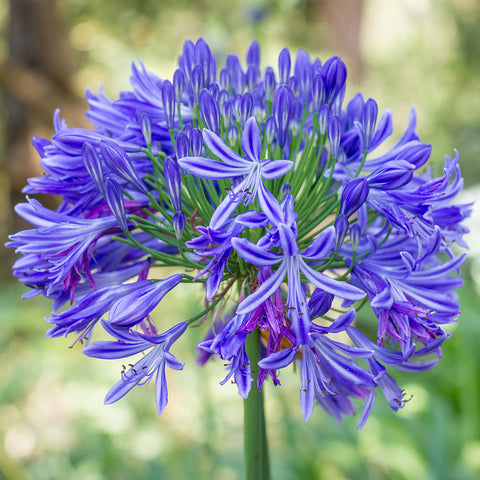Sensational Agapanthus: Enhancing Your Yard's Appeal
Sensational Agapanthus: Enhancing Your Yard's Appeal
Blog Article
Understanding the Art of Agapanthus Treatment: Essential Steps for Healthy Development and Vivid Blooms
In the world of horticulture, the growing of agapanthus stands as a gratifying venture for those who seek to nurture these sophisticated flowering plants. From choosing the ideal variety to grasping trimming techniques, the journey towards growing flourishing agapanthus plants is multifaceted and holds the key to opening the full possibility of these herb treasures.

Selecting the Right Agapanthus Selection

When picking the appropriate Agapanthus variety for your yard, consider variables such as environment suitability, flower shade, and growth practice. Additionally, consider the climate in your region to make sure the Agapanthus variety you pick can prosper in your details problems. Comprehending the growth routine of different Agapanthus ranges is critical for correct positioning within your garden.
Perfect Planting Conditions
Considering the optimum ecological requirements is crucial for successful Agapanthus cultivation. Agapanthus plants are sensitive to chilly temperature levels and need to be protected from frost throughout winter season months.
To guarantee healthy growth and lively blossoms, plant Agapanthus light bulbs at a depth of about 2-4 inches and area them 8-12 inches apart. Adding raw material, such as garden compost, to the soil can improve drainage and fertility, advertising robust root growth. Mulching around the base of the plants helps keep dampness and subdues weed development. Normal watering is important, particularly during the growing season, to maintain the dirt continually damp however not soaked.
Watering and Fertilizing Tips
Maintaining correct dampness degrees and supplying necessary nutrients are crucial elements in the care regimen for Agapanthus plants. When it concerns sprinkling Agapanthus, it is vital to strike an equilibrium. These plants like constantly wet soil but are at risk to root rot if overwatered. During the growing period, water deeply once a week, guaranteeing the soil is well-draining to protect against waterlogging. In hotter climates or throughout periods of drought, even more regular watering might be required to keep the dirt uniformly damp. However, minimize watering in the winter to avoid water logged conditions.
Feeding Agapanthus is necessary for promoting healthy development and respected flowers. Use a balanced fertilizer, such as a 10-10-10 formula, in the early spring as brand-new development arises. Repeat this application every 6-8 weeks throughout the growing period. Avoid extreme fertilization, as it can result in lush foliage at the cost of blossoms. Always adhere to the producer's instructions for correct dilution and application techniques. By following these watering and feeding tips, you can ensure your Agapanthus plants grow and generate dynamic, lasting flowers.
Pruning Techniques for Agapanthus
Trimming Agapanthus plants at the appropriate times and with proper methods is vital for preserving their health and promoting ideal growth and blooming. The perfect time to prune Agapanthus remains in late winter season or early springtime before new development emerges. Start by getting rid of any yellowing or dead fallen leaves near the base of the plant. Cut them as close to the ground as feasible without damaging the emerging shoots.
For flowered stems, wait till the blossoms have withered and after that trim them back to the base. This not just cleans up the plant's appearance yet likewise encourages the growth of new flower buds. Deadheading invested flowers can additionally reroute the plant's power into producing even more blooms as opposed to establishing seeds. Nevertheless, if you wish to gather seeds for propagation, leave some blossoms to fully grown and dry on the plant.
Keep in mind to use clean, sharp devices to make exact cuts and minimize the risk of presenting illness. Agapanthus. Normal pruning will aid maintain your Agapanthus looking healthy and cool while making certain an abundant display screen of lovely blooms
Taking Care Of Common Bugs and Conditions
After guaranteeing correct pruning methods for Agapanthus, it is vital to address usual from this source pests and conditions that can influence the wellness and vigor of these plants. One usual insect that affects Agapanthus is the Agapanthus gall midget.
An additional usual concern is fungal leaf area, which offers as dark sores on the fallen leaves. To stop fungal diseases, make certain excellent air circulation around the plants, prevent overhanging watering, and eliminate any type of contaminated leaves quickly. In addition, Agapanthus plants can struggle with root rot if they are grown in inadequately draining soil. To avoid this, plant Agapanthus in well-draining soil and stay clear of overwatering. By being Visit Website vigilant and taking prompt activity versus illness and insects, you can help your Agapanthus plants flourish and generate lively flowers.

Verdict
Finally, grasping the art of agapanthus care involves picking the ideal variety, supplying excellent planting conditions, correct watering and feeding, suitable trimming strategies, and addressing usual parasites and conditions. By adhering to these necessary actions, you can ensure healthy development and lively flowers for your agapanthus plants. Remember to on a regular basis keep an eye on and preserve your plants to promote their general health and long life.
To make certain healthy and balanced growth and dynamic flowers, plant Agapanthus bulbs Visit This Link at a deepness of about 2-4 inches and room them 8-12 inches apart. By adhering to these watering and fertilizing tips, you can guarantee your Agapanthus plants thrive and create vivid, resilient blooms.
One usual parasite that influences Agapanthus is the Agapanthus gall midget. Furthermore, Agapanthus plants can endure from root rot if they are grown in poorly draining soil. By following these essential actions, you can guarantee healthy and balanced growth and lively flowers for your agapanthus plants.
Report this page